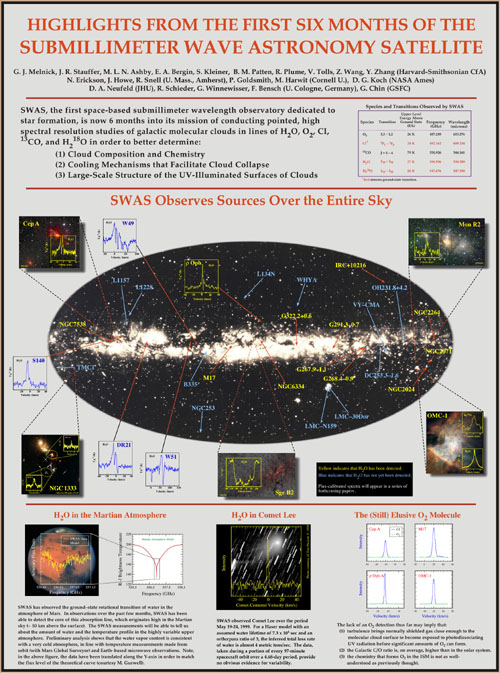|
Highlights from the First Six Months of the Submillimeter Wave Astronomy Satellite
Melnick, G. J., Stauffer, J. R., Ashby, M. L. N., Bergin, E., Kleiner, S.,
Patten, B., Plume, R., Tolls, V., Wang, Z., Zhang, Y., Erickson, N.,
Howe, J., Snell, R., Goldsmith, P., Harwit, M., Koch, D. G., Neufeld, D.,
Schieder, R., Winnewisser, G., Bensch, F., Chin, G.
The Submillimeter Wave Astronomy Satellite (SWAS), a NASA Small Explorer class mission dedicated to the
study of star formation and interstellar chemistry, has recently completed its first six months of operations. During
this time SWAS has observed a number of galactic regions, including OMC-1, M17, and Sgr B2, at five
frequencies corresponding to either the ground-state or a low-lying transition of H_2O 1_{1,0}-1_{0,1} (557
GHz), (13) CO J = 5-4 (551 GHz), H_2(18) O 1_{1,0}-1_{0,1} (548 GHz), O_2 (J,N) = (3,3)-(2,2) (487 GHz),
and [CI] (3) P_1-(3) P_0 (492 GHz). SWAS employs two independent Schottky barrier diode mixers cooled to
170 K coupled to a 52 x 68 cm off-axis Cassegrain antenna. The SWAS beamsizes are measured to be 3.2' x
4.5' at 551 GHz and 3.6' x 5.0' at 492 GHz with very good (> 20 dB) sidelobe supression. The backend is a 1.4
GHz bandwidth acousto-optical spectrometer which yields a velocity resolution of 1 km s(-1) . We report on our
progress to date including the detection of water toward most regions observed along with large-scale maps of
CI and (13) CO toward OMC-1, M17, and Sgr B2.

[BACK]
|
